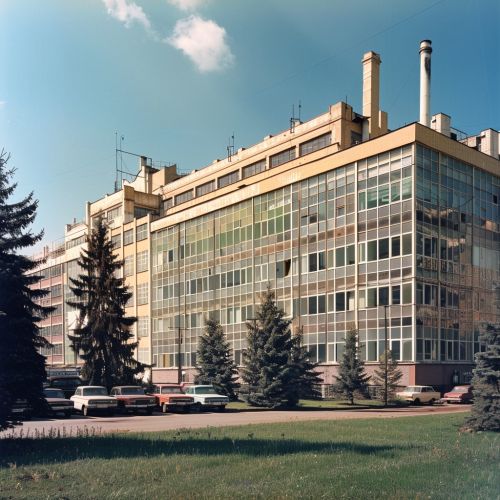AvtoVAZ
History
AvtoVAZ, also known as VAZ (Volzhsky Avtomobilny Zavod), is a Russian automobile manufacturer established in 1966. The company was founded as a joint venture between the Soviet government and the Italian car manufacturer Fiat. The primary objective was to produce affordable and reliable cars for the Soviet populace. The first model, the VAZ-2101, was based on the Fiat 124 and was introduced in 1970. This model, known as the Lada in export markets, became the cornerstone of AvtoVAZ's production line.


Production Facilities
AvtoVAZ's main production facility is located in Tolyatti, Samara Oblast. This plant is one of the largest car manufacturing plants in the world, covering an area of over 600 hectares. The facility includes stamping, welding, painting, and assembly shops, as well as a dedicated research and development center. The plant has a production capacity of approximately 800,000 vehicles per year.
Stamping Shop
The stamping shop is equipped with high-capacity presses that shape metal sheets into various car body parts. The shop uses advanced automation and robotics to ensure precision and efficiency. The stamping process involves several stages, including blanking, forming, trimming, and piercing.
Welding Shop
In the welding shop, stamped parts are assembled into car bodies. The shop employs a combination of manual and robotic welding techniques. Robotic arms perform spot welding, seam welding, and arc welding to ensure strong and durable joints. Quality control measures, such as ultrasonic testing and X-ray inspection, are used to detect any defects.
Painting Shop
The painting shop uses state-of-the-art electrocoating and spray painting techniques to apply protective and decorative coatings to car bodies. The process includes pre-treatment, primer application, base coat application, and clear coat application. The shop is equipped with automated paint booths and curing ovens to ensure a high-quality finish.
Assembly Shop
The assembly shop is where the painted car bodies are fitted with various components, such as engines, transmissions, suspension systems, and interiors. The shop uses a combination of conveyor belts and automated guided vehicles to transport car bodies and components. Quality control measures, such as torque monitoring and functional testing, are used to ensure that each vehicle meets the required standards.
Research and Development
AvtoVAZ's research and development center is responsible for designing new models, improving existing models, and developing new technologies. The center employs a team of engineers, designers, and technicians who work on various aspects of vehicle development, including aerodynamics, crash safety, and fuel efficiency. The center is equipped with advanced testing facilities, such as wind tunnels, crash test labs, and engine test benches.
Product Line
AvtoVAZ produces a wide range of vehicles, including compact cars, sedans, hatchbacks, SUVs, and commercial vehicles. The company's most popular models include the Lada Granta, Lada Vesta, Lada XRay, and Lada Niva.
Lada Granta
The Lada Granta is a compact car that was introduced in 2011. It is available in sedan, hatchback, and liftback body styles. The Granta is powered by a range of gasoline engines, including 1.6-liter and 1.8-liter units. The car is known for its affordability, reliability, and practicality.
Lada Vesta
The Lada Vesta is a compact sedan that was introduced in 2015. It is available in sedan and station wagon body styles. The Vesta is powered by a range of gasoline engines, including 1.6-liter and 1.8-liter units. The car is known for its modern design, advanced features, and comfortable ride.
Lada XRay
The Lada XRay is a subcompact crossover SUV that was introduced in 2016. It is available in front-wheel-drive and all-wheel-drive configurations. The XRay is powered by a range of gasoline engines, including 1.6-liter and 1.8-liter units. The car is known for its stylish design, high ground clearance, and versatility.
Lada Niva
The Lada Niva is a compact SUV that was introduced in 1977. It is available in three-door and five-door body styles. The Niva is powered by a range of gasoline engines, including 1.7-liter and 1.8-liter units. The car is known for its rugged design, off-road capability, and durability.
Market Presence
AvtoVAZ is the largest car manufacturer in Russia and one of the leading car manufacturers in Eastern Europe. The company has a strong presence in the domestic market, with a market share of approximately 20%. AvtoVAZ also exports its vehicles to various countries, including Kazakhstan, Belarus, Ukraine, and Egypt. The company's export strategy focuses on emerging markets with growing demand for affordable and reliable vehicles.
Joint Ventures and Partnerships
AvtoVAZ has established several joint ventures and partnerships with other car manufacturers to enhance its production capabilities and expand its product line. The most notable partnership is with the French car manufacturer Renault, which acquired a controlling stake in AvtoVAZ in 2012. This partnership has enabled AvtoVAZ to benefit from Renault's expertise in vehicle design, production, and marketing.
Challenges and Future Prospects
AvtoVAZ faces several challenges, including economic instability, competition from foreign car manufacturers, and changing consumer preferences. The company is focusing on improving its product quality, expanding its product line, and enhancing its production efficiency to address these challenges. AvtoVAZ is also investing in new technologies, such as electric vehicles and autonomous driving, to stay competitive in the evolving automotive industry.
